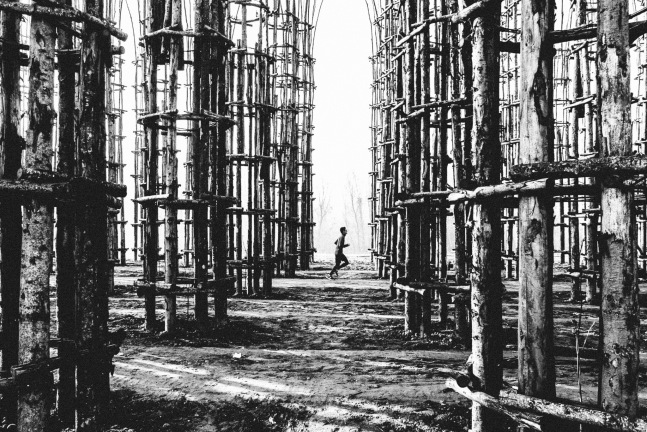Place is not always obvious, stationery, physical. As it has been researched before by our predecessors, it has become a metaphorical source of being.
We project our own subconscious world in order to pinpoint, cartograph and experience the place.
Often because of these memories and connections of our own, the physical place takes a new meaning. It turns into a symbolic area of an event, of a concept, of man.
This reminded me a very site-specific artwork Cattedrale Vegetale, by Giuliano Mauri.
A work that changes over time and creates a bonding with the place it’s built on.
In his words, “…This place will always remember me, and this makes me happy. I like to think that people will walk through this place and wonder why it was erected, why they built it, a question that will stem out spontaneously, realizing that the work is worth the place”. ”
It’s interesting to note that the structure was erected after the artist’s death, by his family, friends, town’s municipality and other artists that wanted to finish his work in a sort of homage to him. The area itself has have had to be cleaned and reclaimed.

*
We perceive space, as the limited area of focus of a place, that we can explore.
God is place, place is infinite, therefore God is infinite.
Place -through time- becomes a part of space, a measurable space becomes a site. It is now often interchangeable.
I happened to recently watch a documentary with Michal Rovner‘s work on Makom II. Makom, as she explained, means place and God in both Hebrew and Arabic. She used stone from Palestinian and Israeli dismantled or destroyed houses and cut each one of them in a unique way. The stones are also marked so the whole structure can be rebuilt in any other place.
The structures although sturdy, they have no possible entry which makes the hypothetical residents, bare of home and land. On some of the sides of the buildings, we see -well calculated- cracks, a reminiscent of the war torn area the stones come from.
The title implies there was a previous project before. Maybe the importance of place is more divine here, the first Makom being God, maybe?
According to Heidegger‘s anthropocentric philosophy, in order to create you need to destroy nature. Nature is easier to destroy when there is nothing manmade for us to feel connected to.
In that regard, artists don’t need to destroy previous art to be able to create and when they attempt to do so, they still find themselves relying in the teachings of the predecessors.
The problem with certain places is that it’s difficult to record or capture their magnificence in an accurate, unbiased way. That doesn’t mean they lack in importance, but it makes it easier to ignore the importance of the place.
Art needs to be thoroughly analyzed, experienced and appreciated so it can be truly and fairly understood. As in places, so in Art, it can be taking different forms, meanings and depth.
**
New vocabulary: abstruse= hard to understand, raze=to destroy to the ground, permeability= to penetrate through, saturate.
***
My take on the book extract, follows.
I never thought that place could be such a complicated term in Art with several subcategories. Nevertheless, I found the book unnecessarily abstruse (ha!), often using philosophical quotations that -although seem to relate- do not accurately explain the connection with the subject (i.e. Heidegger’s “standing reserve“), especially concerning a book that is addressed to readers that is only assumed they have the appropriate academic background.
Saying so, I now do have a better grasp of what place is and the differences between that and more measured or defined concepts of place. Will I be able to break down an artwork into which definition it falls in? Probably not. It’s still a lucid term but at least now I know where I should begin.
SOURCES
- DEMPSEY, C. (2012) Time and GIS: Ways of Representing Time on a Map. At: https://www.gislounge.com/time-and-gis/ (Accessed on 8 July 2018)
- (2017) GIULIANO MAURI CATTEDRALE VEGETALE. At: https://divisare.com/projects/345569-giuliano-mauri-cattedrale-vegetale (Accessed on 8 July 2018)
- Cattedrale vegetale – Oltre il Colle BG. (2017) Directed by Dir. Bergamo in Volo. Bergamo in Volo. At: https://www.youtube.com/watch?v=lT_k6D-VxKE&t=54s (Accessed on 8 July 2018)
- Michal Rovner Makom II. At: https://www.pacegallery.com/exhibitions/11634/michal-rovner-makom-ii (Accessed on 8 July 2018)
- Chemla, V. (2011) ‘l« Histoires » de Michal Rovner’ [web log] At: http://www.veroniquechemla.info/2011/07/histoires-de-michal-rovner.html (Accessed on 8 July 2018)




